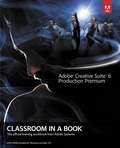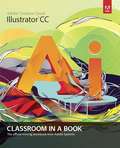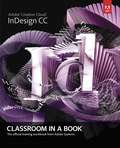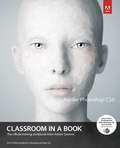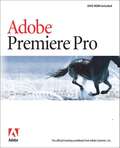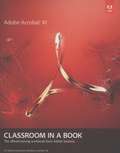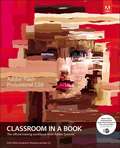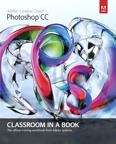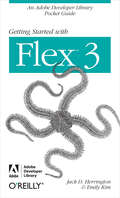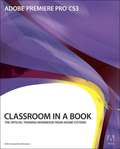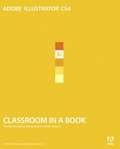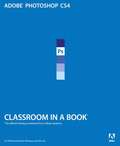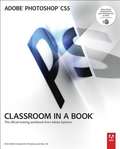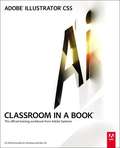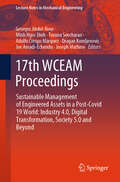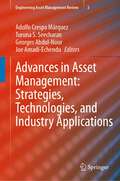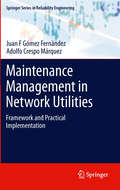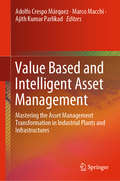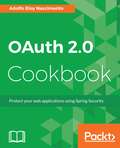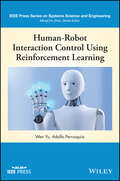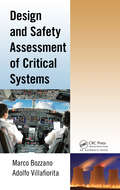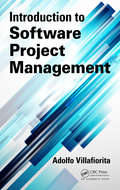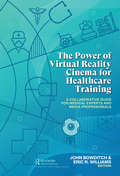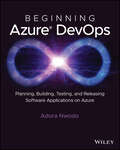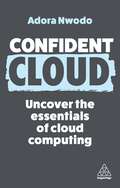- Table View
- List View
Adobe Creative Suite 6 Production Premium: The official training workbook from Adobe Systems (Classroom in a Book Series)
by Adobe Creative TeamThe first book to cover the digital video workflows in Adobe CS6, from the bestselling Classroom in a Book series. Hands-on lessons that use clear step-by-step instructions and screenshots explain the components in Adobe Creative Suite CS6 Production Premium. Covers the entire 'Planning to Playback' workflow for video, including media management, editing, adding effects, working with audio, color correcting, and outputting. Companion DVD includes sample media files for all of the book's projects. Those creative professionals seeking the fastest, easiest, most comprehensive way to learn Adobe Creative Suite CS6 Production Premium choose Adobe Creative Suite CS6 Production Premium Classroom in a Book from the Adobe Creative Team at Adobe Press. (From planning to playback, this book covers it all! With focused attention on the workflow and integration between the components of Production Premium, readers will learn to take their project from concept all the way through the production and post-production pipelines using the all the tools necessary. Chapters cover planning and organizing projects, editing in Premiere Pro, creating motion graphics and visual effects using After Effects, working with audio, color correcting in SpeedGrade (a new product in the suite), finishing and rendering compositions, and authoring for DVDs, Blu-ray Discs, and the Web. Readers will also discover how easy it is to use Adobe Media Encoder and Dynamic Link across the suite for easy-to-manage workflow processes as well.
Adobe Illustrator CC: Classroom in a Book
by Adobe Creative TeamThe fastest, easiest, most comprehensive way to learn Adobe Illustrator CC Classroom in a Book®, the best-selling series of hands-on software training workbooks, offers what no other book or training program does-an official training series from Adobe Systems Incorporated, developed with the support of Adobe product experts. Adobe Illustrator CC Classroom in a Book contains 15 lessons that cover the basics. You can follow the book from start to finish or choose only those lessons that interest you.
Adobe Indesign CC (Classroom in a Book)
by Adobe Creative TeamThe fastest, easiest, most comprehensive way to learn Adobe Illustrator CC --Completely revised edition covers the latest features in Adobe InDesign CC, as includes numerous new tips and sidebars on workflow and best practices. -This guide's 16 project-based lessons teach readers the fundamental concepts and techniques of page layout with InDesign CC. -This book is part of the official training series from Adobe Systems and developed with the support of Adobe product experts. The 16 project-based lessons show students step-by-step the key techniques for working with InDesign CC. Students learn what they need to know to create engaging page layouts, flow and edit text, create and use styles, incorporate graphics and tables, and create PDF forms and ebooks. This completely revised edition covers the new features in Adobe InDesign CC, including the QR code generator and Font Favorites, and it features many redesigned sample documents, numerous new tips and sidebars on workflow and best practices, and more details on high-end typography options such as hyphenation settings. This thorough, self-paced guide is ideal for beginning students wanting to get up to speed on the key features of this program. Those who already have some experience with InDesign can improve their skills and learn InDesign's newest features. New to this InDesign CC edition-students now download the lesson files from the Peachpit website, so they can work along, step-by-step, with the book.
Adobe Photoshop Cs6 (Classroom In A Book)
by Adobe Creative TeamCreative professionals seeking the fastest, easiest, most comprehensive way to learn Adobe Photoshop CS6 choose Adobe Photoshop CS6 Classroom in a Book from the Adobe Creative Team at Adobe Press. The 14 project-based lessons in this book show readers step-by-step the key techniques for working in Photoshop CS6 and how to manipulate images, edit motion-based content, and create image composites. In addition to learning the key elements of the Photoshop interface, this completely revised CS6 edition covers new features, including precise cropping with multiple overlays, expanded content-aware toolkit with skin tone-aware selections and masking, three new blur effects, re-engineered design tools, adaptive Wide Angle adjustments, improved Camera Raw engine, improved auto corrections, Background Save and Auto-recovery, modernized user interface, intuitive video enhancements, simplified 3D interface, improved editing speed with real-time results, and more. In addition to the lesson files, the companion DVD will feature 2 hours of free video tutorials from Adobe Photoshop CS6: Learn by Video by Adobe Press and video2brain, a great added value! "The Classroom in a Book series is by far the best training material on the market. Everything you need to master the software is included: clear explanations of each lesson, step-by-step instructions, and the project files for the students. " --Barbara Binder, Adobe Certified Instructor, Rocky Mountain Training Classroom in a Book®, the best-selling series of hands-on software training workbooks, helps you learn the features of Adobe software quickly and easily. Classroom in a Book offers what no other book or training program does--an official training series from Adobe Systems Incorporated, developed with the support of Adobe product experts. **Breaking News! Adobe has released an update to Photoshop offering new features for Creative Cloud customers including Retina Display Support, Smart Object support for Blur Gallery and Liquify, powerful CSS support for web design, workflow improvements, improved 3D effects and more. Register your book at peachpit. com/register to receive a free update that covers these features.
Adobe Premiere Pro Classroom in a Book
by Adobe Creative TeamMove over Final Cut Pro. There's a new king of the digital video editing hill, and it doesn't even work on a Mac (though it may be enough to lure some Mac loyalists over). Eschewing cross-platform support for a focus on speed, features, and a quickness to market that was impossible to achieve with both Mac and Windows versions, the brand-new Windows XP¿only Adobe Premiere Pro sets a new standard for desktop digital video editing. Here to get you up to speed on it quickly and efficiently is the first and last word on the subject from the folks behind Premiere Pro--the Adobe Creative Team. This project-based volume covers not just the basics of working with audio, creating transitions, and producing titles but also all that's new (and revolutionary) in Premiere Pro: three-point color correction, multiple timelines, a new audio mixer, enhanced media management, and more. Best of all, the accompanying DVD includes real footage that you can practice on!
Adobe Acrobat Xi Classroom In A Book
by Adobe Creative Team StaffAdobe Acrobat XI Classroom in a Book is the most thorough and comprehensive way for creative professionals and business users to learn how to reliably create, edit, and sign PDF documents and forms with Adobe Acrobat XI. Each chapter in this step-by-step, project-based guide contains a project that builds on your growing knowledge of the program, while end-of-chapter review questions reinforce each lesson. This cross-platform (Mac and Windows) book shows you how to collaborate effectively through electronic reviews, easily share your work across multiple platforms and devices, and speed up your production and business task workflow with Acrobat XI. In this new version you'll learn how to use an integrated Acrobat toolbar (for popular Microsoft and browser apps) so you can easily convert files to PDF and then learn how to directly edit text and images in your PDFs. You'll also learn how to build PDF or web forms with the new built-in Adobe FormsCentral desktop app. We'll show you how to speed up your business workflow by gathering feedback and approval via online document reviews. And you'll learn how to create interactive forms and track responses within Acrobat, how to add signatures and security to your PDF files, and much more.
Adobe Flash Professional Cs6 Classroom In A Book
by Adobe Creative Team StaffThose creative professionals seeking the fastest, easiest, most comprehensive way to learn Adobe Flash Professional CS6 choose Adobe Flash Professional CS6 Classroom in a Book from the Adobe Creative Team. The 10 project-based lessons in this book show readers step-by-step the key techniques for working in Flash CS6. Readers learn what they need to know to create engaging interactive content with Flash CS6. In addition to learning the key elements of the Flash interface, including panels, timelines, and frames, readers learn how to work with graphics, create and edit symbols, modify text, add interactivity with ActionScript, and incorporate animation and sound into their projects. They also learn how to prepare and export their finished projects for publishing. This completely revised CS6 edition shows readers how to generate sprite sheets for enhanced game development workflow and deliver apps with a prepackaged Adobe AIR captive runtime for better user experience. The book also covers the new, powerful, and intuitive tools and integrated support for reaching audiences across devices that run on Android and iOS platforms by targeting the Adobe AIR 3. 2 runtime. The companion DVD includes lesson files so readers can work along with the book, as well video training from Learn Adobe Flash Professional CS6 by Video. "The Classroom in a Book series is by far the best training material on the market. Everything you need to master the software is included: clear explanations of each lesson, step-by-step instructions, and the project files for the students. " --Barbara Binder, Adobe Certified Instructor, Rocky Mountain Training Classroom in a Book®, the best-selling series of hands-on software training workbooks, helps you learn the features of Adobe software quickly and easily. Classroom in a Book offers what no other book or training program does--an official training series from Adobe Systems Incorporated, developed with the support of Adobe product experts.
Adobe Photoshop CC: Classroom In A Book
by Adobe Creative Team StaffThe fastest, easiest, most comprehensive way to learn Adobe Photoshop CC Classroom in a Book#65533;, the best-selling series of hands-on software training workbooks, offers what no other book or training program does--an official training series from Adobe Systems Incorporated, developed with the support of Adobe product experts. Adobe Photoshop CC Classroom in a Book contains 14 lessons that cover the basics, providing countless tips and techniques to help you become more productive with the program. You can follow the book from start to finish or choose only those lessons that interest you. Purchasing this book gives you access to the downloadable lesson files you need to work through the projects in the book, and to electronic book updates covering new features that Adobe releases for Creative Cloud customers. For access, goto www. peachpit. com/redeem and redeem the unique code provided inside this book. "The Classroom in a Book series is by far the best training material on the market. Everything you need to master the software is included: clear explanations of each lesson, step-by-step instructions, and the project files for the students. " Barbara Binder, Adobe Certified Instructor Rocky Mountain Training
Getting Started with Flex 3: An Adobe Developer Library Pocket Guide for Developers (Pocket Reference (O'Reilly))
by Jack D. Herrington Emily Kim Adobe Development TeamDiscover how easy RIA development can be with this one-of-a-kind handbook from the Adobe Developer Library. Several clear, step-by-step mini-tutorials teach you about web services, event handling, designing user interfaces with reusable components, and more. After finishing this guide, you'll be able to build Flash applications ranging from widgets to full-featured RIAs using the Flex SDK and Flex Builder 3.0. With Getting Started with Flex 3, you will:Walk through sample RIA projects and see examples of amazing applications people have built with FlexWork with ActionScript 3.0 and the MXML markup languageBuild user interfaces using the controls and tools available with the frameworkGet a tour of controls available commercially and through open sourceLearn how Flex integrates with ASP.NET, ColdFusion, PHP, and J2EE in the serverBuild Flex-based widgets that let you display real-time dataUse advanced controls to build 3D graphs, data dashboards, mapping applications, and moreYou'll find complete code for video players, a slideshow, a chat client, and an RSS reader, just to name a few. You also get plenty of tips, tricks, and techniques to leverage your existing programming skills, whether you come from an open source or Visual Studio-intensive background.
Adobe Premiere Pro CS3
by Adobe PressThe best-selling guide to Adobe's powerful digital video editing application, now fully updated to cover the newest version of Premiere Pro.
Adobe Illustrator CS4: Classroom in a Book
by Adobe SystemsThe fastest, easiest, most comprehensive way to learn Adobe Illustrator CS4 Adobe Illustrator CS4 Classroom in a Book contains 15 lessons. The book covers the basics of learning Illustrator and provides countless tips and techniques to help you become more productive with the program. You can follow the book from start to finish or choose only those lessons that interest you. Learn how to create artwork for illustrations, logos, stationery, page layouts, posters, and integrate with Adobe Flash movies, Adobe In Design layouts, and more! "The Classroom in a Book series is by far the best training material on the market. Everything you need to master the software is included: clear explanations of each lesson, step-by-step instructions, and the project files for the students. " -Barbara Binder, Adobe Certified Instructor, Rocky Mountain Training Classroom in a Book , the best-selling series of hands-on software training workbooks, helps you learn the features of Adobe software quickly and easily. Classroom in a Book offers what no other book or training program does-an official training series from Adobe Systems Incorporated, developed with the support of Adobe product experts.
Adobe Photoshop CS4: Classroom in a Book
by Adobe SystemsThe fastest, easiest, most comprehensive way to learn Adobe Photoshop CS4 Fourteen lessons in Adobe Photoshop CS4 Classroom in a Book cover basic and advanced techniques in Adobe Photoshop, the world's best image-editing software. Learn how to retouch digital photos, work with layers and masks, navigate the workspace, prepare images print, and explore the latest features. Tips, extra-credit exercises, and step-by-step lessons help you become more productive using Photoshop. Learn to correct and enhance digital photos, create image composites, transform images in perspective, and prepare images for print and the web. Combine images for extended depth of field, and try out the new 3D features in Adobe Photoshop CS4 Extended. "The Classroom in a Book series is by far the best training material on the market. Everything you need to master the software is included: clear explanations of each lesson, step-by-step instructions, and the project files for the students. " -Barbara Binder, Adobe Certified Instructor, Rocky Mountain Training Classroom in a Book , the best-selling series of hands-on software training workbooks, helps you learn the features of Adobe software quickly and easily. Classroom in a Book offers what no other book or training program does-an official training series from Adobe Systems Incorporated, developed with the support of Adobe product experts.
Classroom in a Book: The Official Training Workbook
by Adobe SystemsThis official guide to Adobe's popular Photoshop CS5 provides step-by-step instructions for performing common tasks with this ubiquitous image manipulation application. Beginning with an overview of the software and the desktop environment, the volume covers such topics as photo corrections, working with selection tools, layers, enhancing digital photos, masks and channels, typography, vector drawing, advanced compositing, 3D images and the preparation of finished files for printing or the web. The material is well-illustrated with numerous color figures and screen shots and a DVD-Rom containing sample files and video tutorials is included. This is an official publication from Adobe.
Classroom in a Book: The Official Training Workbook
by Adobe SystemsCreative professionals seeking the fastest, easiest, most comprehensive way to learn Adobe Illustrator CS5 choose Adobe Illustrator CS5 Classroom in a Book from the Adobe Creative Team at Adobe Press. The 15 project-based lessons in this book show readers step-by-step the key techniques for working in Illustrator CS5. Readers learn how to create vector artwork for virtually any project and across multiple media: print, websites, interactive projects, and video. In addition to learning the key elements of the Illustrator interface, they'll learn how to integrate their artwork with Adobe Flash movies, Adobe In Design layouts, and Adobe Flash Catalyst software to add interaction to their designs. This completely revised CS5 edition covers new perspective drawing tools, variable-width watercolor strokes, multiple art boards with video-specific presets, the new realistic Bristle brush and Shape Builder tool, and the ability to maintain consistent raster effects across media. "The Classroom in a Book series is by far the best training material on the market. Everything you need to master the software is included: clear explanations of each lesson, step-by-step instructions, and the project files for the students. " -Barbara Binder, Adobe Certified Instructor, Rocky Mountain Training Classroom in a Book , the best-selling series of hands-on software training workbooks, helps you learn the features of Adobe software quickly and easily. Classroom in a Book offers what no other book or training program does-an official training series from Adobe Systems Incorporated, developed with the support of Adobe product experts.
17th WCEAM Proceedings: Sustainable Management of Engineered Assets in a Post-Covid 19 World: Industry 4.0, Digital Transformation, Society 5.0 and Beyond (Lecture Notes in Mechanical Engineering)
by Joseph Mathew Adolfo Crespo Márquez Joe Amadi-Echendu Dragan Komljenovic Turuna Seecharan Georges Abdul-Nour Minh Ngoc Dinh17th WCEAM Proceedings provides a record of some of the intellectual discussions (including keynote addresses, research paper presentations, panel debates and practical workshops) that took place among the attendees and participants of the 17th World Congress on Engineering Asset Management (WCEAM), held from 18 - 20 October 2024 at the Sheraton Saigon Hotel and Towers, Ho Chi Minh City, Vietnam. The events were organized by the International Society for Engineering Asset Management (ISEAM) and hosted by RMIT University Vietnam LLC (RMIT VN), Ho Chi Ming City. The content of the book includes topics listed below under a general theme of Sustainable Management of Engineered Assets in a Post-Covid World: Industry 4.0, Digital Transformation, Society 5.0 and beyond Sustainable asset investment, acquisition, operations, maintenance, and retirement strategies Production-service transformation and product-service systems Sustainable asset acquisition, operations, maintenance, and retirement processes Modeling and simulation of acquisition, operations, maintenance, and retirement processes Reliability and resilience engineering Applications of the Fourth Industrial Revolution (4IR) technologies in EAM, e.g., Digital Twins Cybersecurity issues in asset management Asset condition, risk, resilience, and vulnerability assessments Asset management and decision support systems Applications of international and logical guidelines and standards in EAM Human dimensions and asset management performance Case studies of asset management in various industries and sectors This proceedings is an excellent resource for asset management practitioners, researchers and academics, as well as undergraduate and postgraduate students.
Advances in Asset Management: Strategies, Technologies, and Industry Applications (Engineering Asset Management Review #3)
by Adolfo Crespo Márquez Joe Amadi-Echendu Georges Abdul-Nour Turuna S. SeecharanThis book discusses asset life-cycle management, especially, human dimensions on the management of infrastructure and industry-sector assets. The book explores advances decision support systems based on the applications of Fourth Industrial Revolution (4IR) technologies such as augmented reality (AR) and virtual reality (VR), machine learning, and digital twinning for monitoring, diagnostics, prognostics. It includes methodologies and cases applied to different operational contexts. The book also considers the implications of the applications of international standards, local regulations and industry guidelines to risk and resilience engineering asset operations.
Maintenance Management in Network Utilities
by Adolfo Crespo Márquez Juan F Gómez FernándezIn order to satisfy the needs of their customers, network utilities require specially developed maintenance management capabilities. Maintenance Management information systems are essential to ensure control, gain knowledge and improve-decision making in companies dealing with network infrastructure, such as distribution of gas, water, electricity and telecommunications. Maintenance Management in Network Utilities studies specified characteristics of maintenance management in this sector to offer a practical approach to defining and implementing the best management practices and suitable frameworks. Divided into three major sections, Maintenance Management in Network Utilities defines a series of stages which can be followed to manage maintenance frameworks properly. Different case studies provide detailed descriptions which illustrate the experience in real company situations. An introduction to the concepts is followed by main sections including: * A Literature Review: covering the basic concepts and models needed for framework design, development and implementation. * Framework Design and Definition: developing the basic pillars of network utilities maintenance management framework. * Performance Evaluation & Maturity: focusing on the reliability concept and maturity models from different viewpoints. By establishing basic foundations for creating and maintaining maintenance managements strategies, Maintenance Management in Network Utilities acts a practical handbook for all professionals in these companies and across areas such as network development, operations management and marketing.
Value Based and Intelligent Asset Management: Mastering the Asset Management Transformation in Industrial Plants and Infrastructures
by Adolfo Crespo Márquez Marco Macchi Ajith Kumar ParlikadThe fundamental motivation of this book is to contribute to the future advancement of Asset Management in the context of industrial plants and infrastructures. The book aims to foster a future perspective that takes advantage of value-based and intelligent asset management in order to make a step forward with respect to the evolution observed nowadays. Indeed, the current understanding of asset management is primarily supported by well-known standards. Nonetheless, asset management is still a young discipline and the knowledge developed by industry and academia is not set in stone yet. Furthermore, current trends in new organizational concepts and technologies lead to an evolutionary path in the field. Therefore, this book aims to discuss this evolutionary path, starting first of all from the consolidated theory, then moving forward to discuss: • The strategic understanding of value-based asset management in a company; • An operational definition of value, as a concept on the background of value-based asset management; • The identification of intelligent asset management, with the aim to frame a set of “tools” recommended to support the asset-related decision-making process over the asset lifecycle; • The emergence of new technologies such as cyber physical systems and digital twins, and the implications of this on asset management.
OAuth 2.0 Cookbook
by Adolfo Eloy NascimentoEfficiently integrate OAuth 2.0 to protect your mobile, desktop, Cloud applications and APIs using Spring Security technologies. About This Book • Interact with public OAuth 2.0 protected APIs such as Facebook, LinkedIn and Google. • Use Spring Security and Spring Security OAuth2 to implement your own OAuth 2.0 provider • Learn how to implement OAuth 2.0 native mobile clients for Android applications Who This Book Is For This book targets software engineers and security experts who are looking to develop their skills in API security and OAuth 2.0. Prior programming knowledge and a basic understanding of developing web applications are necessary. As this book's recipes mostly use Spring Security and Spring Security OAuth2, some prior experience with Spring Framework will be helpful. What You Will Learn • Use Redis and relational databases to store issued access tokens and refresh tokens • Access resources protected by the OAuth2 Provider using Spring Security • Implement a web application that dynamically registers itself to the Authorization Server • Improve the safety of your mobile client using dynamic client registration • Protect your Android client with Proof Key for Code Exchange • Protect the Authorization Server from invalid redirection In Detail OAuth 2.0 is a standard protocol for authorization and focuses on client development simplicity while providing specific authorization flows for web applications, desktop applications, mobile phones, and so on. This book also provides useful recipes for solving real-life problems using Spring Security and creating Android applications. The book starts by presenting you how to interact with some public OAuth 2.0 protected APIs such as Facebook, LinkedIn and Google. You will also be able to implement your own OAuth 2.0 provider with Spring Security OAuth2. Next, the book will cover practical scenarios regarding some important OAuth 2.0 profiles such as Dynamic Client Registration, Token Introspection and how to revoke issued access tokens. You will then be introduced to the usage of JWT, OpenID Connect, and how to safely implement native mobile OAuth 2.0 Clients. By the end of this book, you will be able to ensure that both the server and client are protected against common vulnerabilities. Style and approach With the help of real-world examples, this book provides step by step recipes for troubleshooting and extending your API security. The book also helps you with accessing and securing data on mobile, desktop, and cloud apps with OAuth 2.0.
Human-Robot Interaction Control Using Reinforcement Learning (IEEE Press Series on Systems Science and Engineering)
by Wen Yu Adolfo PerrusquiaA comprehensive exploration of the control schemes of human-robot interactions In Human-Robot Interaction Control Using Reinforcement Learning, an expert team of authors delivers a concise overview of human-robot interaction control schemes and insightful presentations of novel, model-free and reinforcement learning controllers. The book begins with a brief introduction to state-of-the-art human-robot interaction control and reinforcement learning before moving on to describe the typical environment model. The authors also describe some of the most famous identification techniques for parameter estimation. Human-Robot Interaction Control Using Reinforcement Learning offers rigorous mathematical treatments and demonstrations that facilitate the understanding of control schemes and algorithms. It also describes stability and convergence analysis of human-robot interaction control and reinforcement learning based control. The authors also discuss advanced and cutting-edge topics, like inverse and velocity kinematics solutions, H2 neural control, and likely upcoming developments in the field of robotics. Readers will also enjoy: A thorough introduction to model-based human-robot interaction control Comprehensive explorations of model-free human-robot interaction control and human-in-the-loop control using Euler angles Practical discussions of reinforcement learning for robot position and force control, as well as continuous time reinforcement learning for robot force control In-depth examinations of robot control in worst-case uncertainty using reinforcement learning and the control of redundant robots using multi-agent reinforcement learning Perfect for senior undergraduate and graduate students, academic researchers, and industrial practitioners studying and working in the fields of robotics, learning control systems, neural networks, and computational intelligence, Human-Robot Interaction Control Using Reinforcement Learning is also an indispensable resource for students and professionals studying reinforcement learning.
Design and Safety Assessment of Critical Systems
by Marco Bozzano Adolfo VillafioritaSafety-critical systems, by definition those systems whose failure can cause catastrophic results for people, the environment, and the economy, are becoming increasingly complex both in their functionality and their interactions with the environment. Unfortunately, safety assessments are still largely done manually, a time-consuming and error-prone
Introduction to Software Project Management
by Adolfo VillafioritaAlthough software development is one of the most complex activities carried out by man, sound development processes and proper project management can help ensure your software projects are delivered on time and under budget. Providing the know-how to manage software projects effectively, Introduction to Software Project Management supplies an acces
The Power of Virtual Reality Cinema for Healthcare Training: A Collaborative Guide for Medical Experts and Media Professionals
by Bob Fine Eric R. Williams John Bowditch Adonis DuradoCinematic Virtual Reality brings a combination of documentary, narrative and game design principles to the medical profession and, in the healthcare arena, collaboration is a key component for creating intellectually- and emotionally- rich immersive experiences. "The Power of Virtual Reality Cinema for Healthcare Training" gathers more than a dozen experts from both the production and healthcare fields to break down best practices for creating successful cine-VR projects. Designed for multi-disciplinary teams interested in integrating cine-VR production into their healthcare training and educational programs, this book has been written for two audiences: the healthcare professional interested in what production experts consider when approaching a project, and the media expert curious about how this new technology can be used in the medical field. Highlights include: Cutting edge medical education techniques developed by Ohio University’s GRID Lab, including: PREality (creating a forced sense of deja-vu to increase acclimation time), a unique approach to eye-tracking to enhance team performance, and the low-CRIS technique (a low-cost rapid implementation strategy to capture patient care for rapid graduate student training). Insightful production techniques that will enhance your cine-VR projects including advanced plating methods to hide lighting set-ups, immersive audio considerations, and new ways to consider 360 storytelling including the Lovrick montage and the Christmas Carol continuum for story development. Detailed explanations of the production considerations and results of specific cine-VR productions (from funding approaches to distribution) including access to more than five hours of cine-VR examples of the actual productions available for download. Details on a wide variety of medical cine-VR projects, including 100 images that illustrate best practices for topics such as recording in active medical facilities, building successful multi-disciplinary teams, working within HIPAA regulations, conceptualizing cine-VR libraries for graduate education, and implementing innovative distribution models.
Beginning Azure DevOps: Planning, Building, Testing, and Releasing Software Applications on Azure
by Adora NwodoThe perfect DevOps guide for beginning Azure users In Beginning Azure DevOps: Planning, Building, Testing and Releasing Software Applications on Azure, award-winning software engineer Adora Nwodo delivers a beginner's guide to DevOps on the Microsoft-powered Azure cloud platform. In the book, you'll learn to deploy Azure's built-in DevOps tools required to plan, build, test, and ship applications. The author explains how to use Azure's functionality for project management, version control, code testing, and continuous integration and continuous delivery (CI/CD). She discusses how to plan software development projects from start to finish using Agile and Scrum techniques. Readers will also find: Updated source code repositories on GitHub with instructive practice exercises Strategies for improving collaboration and automating your code-to-cloud workflows Techniques for securing your code with advanced capabilities An essential resource for Azure novices who hope to learn about the myriad possibilities unlocked by Azure DevOps tools, Beginning Azure DevOps will also earn a place in the libraries of software professionals familiar with other cloud platforms who hope to gain a foothold in the Azure cloud environment.
Confident Cloud: Uncover the Essentials of Cloud Computing (Confident Series #17)
by Adora Nwodo94% of all enterprises depend upon cloud services. Gain the edge in your career with this essential guide to the fundamental concepts and platforms of cloud computing.Cloud computing is part of our everyday lives, from cloud backups of personal data to cloud platforms powering businesses around the world. But do you really understand how cloud computing works? This comprehensive guide demystifies key concepts and gives you the confidence you need to succeed in this sector.Confident Cloud includes key concepts from FinOps and DevOps to Kubernets and automation. This is supported by practical guidance on working in the industry, alongside a variety of fascinating case studies, clarifying how cloud infrastructure is effectively deployed and maintained.About the Confident series...From coding and data science to cloud and cybersecurity, the Confident books are perfect for building your technical knowledge and enhancing your professional career.
